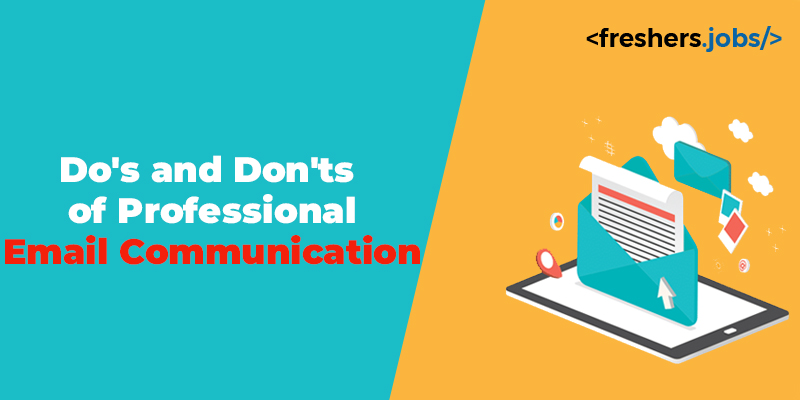In today’s professional world, email has become an essential form of communication. But however, building a professional email etiquette for freshers jobs can be a challenging task.

To ensure that your email is professional, it is important for you all to familiarize yourself with certain dos and don’ts while writing an email. So in this blog, we will explore the dos and don’ts for freshers when writing a professional email.
Why is it very important to build a professional email?
Email is a main source of communication in the professional environment. Its effectiveness can have a strong impact on the candidate’s career. Listed below are the importance of a professional email.
- First Impression: An email is typically the first mode of communication between the candidate and potential employers. A professionally written email establishes a strong impression on the candidate.
- Credibility and trust: A well-structured and error-free email enhances your credibility and promotes trust among employers. A professional email demonstrates your competence and reliability.
- Effective Communication: A well-structured and clear email conveys the information more effectively. When it comes to professional email communication, it should be in such a way that your information is understood easily.
- Respect for Recipient: If you use proper etiquette in your email, it will show respect for your recipient’s time and professionalism. It will enhance your reputation as a person who respects someone’s time and needs.
- Networking and professional relationships: A well-crafted email facilitates networking and professional relationships. Efficient communication can lead to new job opportunities, partnerships and collaboration.
- Attention to detail: A professional email demonstrates your attention to detail. Accuracy in spelling, grammar and formatting reflects your excellence and commitment. This will reflect your commitment and excellence, contribute to a positive impression, and convey your dedication to maintaining a high standard in your professional communication.
- Reduces Misunderstandings: A professionally written email reduces the risk of misunderstanding. The clarity in your communication helps to prevent misinterpretations and potential conflicts.
- Reflects your value: Professional email writing reflects your value as a professional and shows your seriousness and commitment to work while indicating your respect for effective communication and attention to detail.
- Adaptability: Building a professional and well-crafted email will help you to adapt and adjust the tone and style of your communication appropriately and enable you to connect effectively with the recipients and navigate various professional scenarios with finesse and confidence.
- Career Advancement: As you progress in your career, your ability to write a clear and professional email is very important. This can impact your chances of new opportunities, leadership roles, and promotions.
- Positive work culture: In the Company, professional email contributes to positive work culture. Clear and effective communication enhances overall productivity and teamwork. by minimizing misunderstandings, promoting collaboration and creating an environment where colleagues can interact with clarity and respect, which ultimately leads to shared success.
Are you in search of job openings in Noida? Then look for job openings available in that city. Visit fresher job openings in Noida to find job roles that are relevant to your skills and abilities.
Challenges faced when writing a professional email
Listed below are the challenges faced during a professional email writing.
- Tone and Etiquette: Striking the right tone is a very important aspect in writing a professional email. Avoiding unnecessary ambiguity and balancing the politeness and warmth in your tone can be challenging.
- Clarity and conciseness: Conveying your message clearly and concisely while including all relevant information can be tricky, as you need to provide enough context without overwhelming the reader.
- Email overloading: Managing a high volume of emails can lead to delay in response. Prioritizing and organizing your inbox is an essential yet challenging task. It requires efficient time management skills and the ability to differentiate between urgent and less time-sensitive communications to ensure that important matters are addressed promptly.
- Attachment Management: Ensuring that attachments are relevant and easily accessible is a challenging task. Attaching large files can also lead to delayed delivery, which potentially causes inconvenience for recipients
- Repetition of phrases: Avoiding repetition of certain phrases to manage the length and flow of the email communication and using different phrases to express it can be challenging. But avoiding repetition of phrases can enhance the impact and readability of your email.
- Professional sign-off: Using the appropriate closing and sign-off that matches the level of formality and your relationship with the recipient is a very essential yet challenging task.
- Grammar and Spelling errors: Ensuring that your email is grammatically correct and doesn’t have any spelling errors is a tricky task. But it is essential for maintaining professionalism and ensuring that your message is conveyed appropriately and clearly to the recipients.
- Delicate Topics: Addressing sensitive and critical topics while maintaining a professional tone and minimizing the potential misunderstandings can be quite challenging.
- Formatting: Ensuring that the format of your email is correct in various devices including your mobile phone can be a quite challenging task. This challenge typically indicates the necessity of crafting emails that adapt easily to different screens.
- Personalization: Maintaining a balance between personalized content and profession related content in your email can be challenging. Excessive personalization might dilute the core purpose of the email
- Politeness: Addressing different opinions and disagreements in a polite and respectful tone can be quite challenging. The challenge in this is effectively communicating your perspective while maintaining a respectful and considerate tone.
Tech Mahindra offers diverse job openings for freshers. Candidates can visit Tech Mahindra Jobs For Freshers to apply for job roles that align with their skills and abilities.
How to write a professional email?
Listed below are tips for how to write mail professionally.
- Relevant and clear Subject Line: Your Subject Line should be in such a way that summarizes the content of the email. Keep it concise and relevant to avoid confusions. Ensuring its relevance helps prevent confusion and encourages the recipient to engage with the email, leading to better communication.
- Appropriate Salutation: Start with a formal greeting that suits the recipient’s relationship with you. Dear [Recipient Name] is a safe choice, but adjust it based on your familiarity with the recipient.
- Introduction: In the opening paragraph, introduce yourself and establish the context. Mention any previous connection or correspondence to provide clarity. This facilitates a flow of communication and ensures that they have the necessary background to engage effectively with your message.
- Consistent Content: Ensure that your email content is focused on to the point. Convey your purpose or content within the first few lines, providing recipients with immediate clarity about the nature of your communication and encouraging them to engage further with the details you’ve presented.
- Logical organization: Use paragraphs to break up your content. Ensure that each paragraph conveys a specific point, making the content look easy to read and understand. It will help you to create a reader-friendly format that enhances the readability of your email
- Bullet points: By using bullet points or numbered lists for listing will help you present the information neatly. This will increase comprehension and readability. Utilizing these formatting techniques allows you to break down complex details into easy points and makes it simpler for recipients to process the information.
- Reply promptly: You should know how to respond to an email professionally and in a timely manner. This will not only demonstrates your commitment to effective communication but also showcases your respect for the sender’s time and urgency
- Professional language: Use a formal language to ensure the professional flow throughout the email. By using a formal language style, you showcase your competence, respect, and professionalism to the recipient.
- Stick to the topic: Stick to the subject of the email to convey the point more effectively. Ensure that your communication remains focused and relevant, facilitating better understanding and reducing the risk of misinterpretation
- Address questions and concerns: If you are addressing queries or concerns, provide clear answers. Consider using formatting or headers to distinguish questions from answers.
- Positive tone: Always maintain a respectful and positive tone throughout the email and avoid being negative and critical. It will help you to create an atmosphere of professionalism, respect, and collaboration.
- Professional Sign-off: Choose a professional-off that matches your tone and level of relationship with the recipient . “Sincerely”, “Best regards”, or “Thank you” are some common and safe choices.
- Proofreading: Before sending your email, proofread it for spelling, grammar, and formatting errors. Mistakes can affect your professionalism. By carefully proofreading your email, you can rectify mistakes and ensure that your communication is accurate, and free from any errors.
- Attachments: If you are including any attachments, mention them in the body section and ensure that they are relevant to the content of your email guarantees that they add value to the recipient’s understanding.
- Formatting: When it comes to formatting, use a consistent font size, readable font, and appropriate formatting like italics, bold, underline to highlight important points or information.
- Respect recipient’s time: Keep your content short and respect the recipient’s time. If your email is lengthy, then provide a brief overview at the beginning. This approach demonstrates your awareness of their time.
- Preview before sending: Before hitting the send button, take some time to preview your email. Ensure that everything is relevant, accurate and appropriately formatted. This final check allows you to find if there are any potential errors or inconsistencies, ensuring that the email you send reflects your professionalism, attention to detail, and commitment to delivering clear and precise communication.
In conclusion, communication through email has become a part of the business world. It is very important to present it in a clear and precise manner. The presentation of your professional email will also determine your commitment to work. So in this blog, we explored how to write mail, its importance and challenges.






